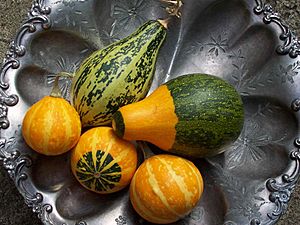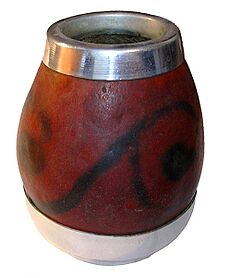Gourd facts for kids
Gourds are amazing plants that belong to the same family as pumpkins. They can grow to be about 12 to 15 inches long. You can find gourds mostly in the United States and Mexico. They often look like a squash and come in colors like orange, brown, or green. People use them in many dishes, such as curries, spaghetti, tacos, and salads.
What Are Gourds?

The word gourd can mean a few things. Sometimes, it describes many plants in the Cucurbitaceae family. This family includes popular foods like pumpkins, cucumbers, squash, luffa, and melons.
More specifically, a gourd often refers to the fruits of plants from two special groups: Lagenaria and Cucurbita. It can also mean the hard, hollow shell of these dried-out fruits. When a gourd dries, its shell becomes very tough.
There are many kinds of gourds all over the world. Some common ones are from the Cucurbita group, which are mostly from North America. These include the Malabar gourd and turban squash. Other famous gourds are the calabash tree gourd from the American tropics and the bottle gourd (Lagenaria siceraria).
Other plants with "gourd" in their name include the luffa gourd, which is used as a scrubbing sponge. There's also the wax gourd, snake gourd, teasel gourd, hedgehog gourd, and buffalo gourd. Even the bitter melon is sometimes called a gourd.
A Look Back: Gourd History
The bottle gourd (L. siceraria) traveled to Europe and the Americas very early in history. Scientists have found gourds at old sites in Peru from 13,000 to 11,000 BC. They also found them in Thailand from 11,000 to 6,000 BC.
A study in 2005 looked at the DNA of bottle gourds. It suggested there were two different types of bottle gourds. They were first grown by people separately in Africa and Asia. The Asian type was grown about 4,000 years earlier. Gourds found in the Americas seem to have come from the Asian type a long time ago. However, a newer study now points to Africa as the origin.
Old records and DNA evidence show that gourds were likely among the first plants people ever grew. This happened in Asia between 12,000 and 13,000 years ago. Gourds might even be the very first plant species that humans domesticated!
Gourds have been used throughout history in almost every culture. When Europeans arrived in North America, they saw that Native Americans used gourds a lot. For example, bottle gourds were used as birdhouses to attract purple martins. These birds helped control bugs in farm fields. Many cultures also made musical instruments from gourds. These included drums, stringed instruments from Africa, and wind instruments like the nose flutes of the Pacific islands.
How Gourds Are Used Today
People in dry places often connected gourds with water. Because of this, gourds appear in many ancient stories about how the world began. From the very start of their history, gourds have had many uses. They were used for food, kitchen tools, toys, musical instruments, and decorations.
Today, gourds are popular for many crafts. People make jewelry, furniture, dishes, and tools from them. They also create a wide range of decorations. Artists use carving, burning, and other methods to make beautiful designs on gourds.
In China, people developed a special way to shape gourds. They would tie a two-part mold around young gourds. The gourd would then grow into the mold and take its shape. These shaped gourds were used for many decorative purposes. They were especially popular as unique boxes, bottles, and other containers.
The luffa gourds, Luffa aegyptiaca and Luffa acutangula, have been used for a long time as scrubbing sponges and strainers. To prepare them, people remove the skin and soft inside part. Then, they bleach the fibers to make the sponge.
Images for kids
-
Gourds at a market in Massachusetts
-
An Indian gourd
-
Chinese snuff bottle (biyanhu) with body from a moulded gourd, and a jade stopper






